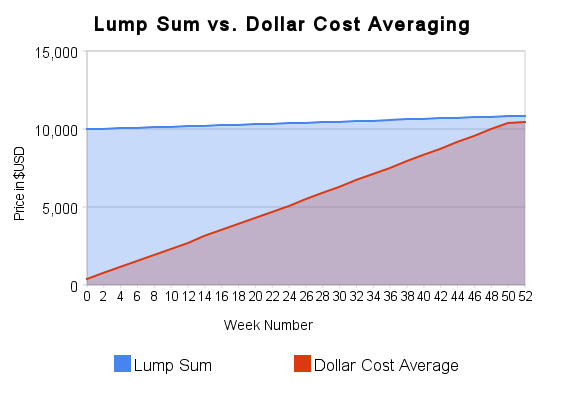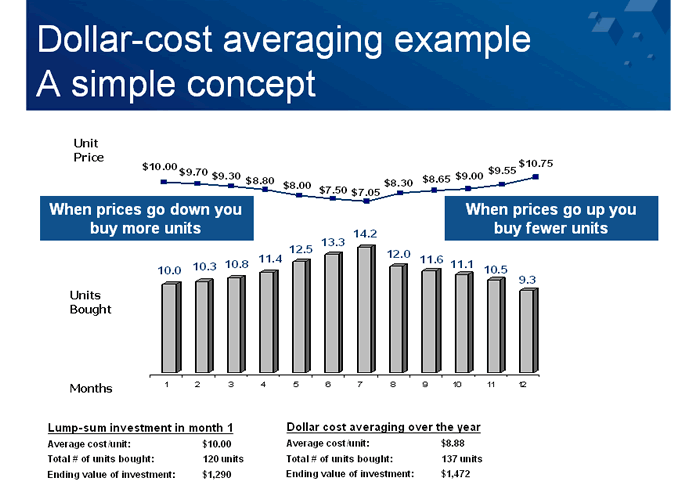Dollar Cost Averaging v Averaging
Post on: 26 Июль, 2015 No Comment

No one wants to lose money, especially money that they’ve worked hard to earn and save. At the same time, just about everyone is trying to increase their portfolio’s value and make as much money as they can.
Some people subscribe to investment newsletters to learn the ’secrets’ of investing, while others are constantly on the lookout for the next big thing in the stock market. Unfortunately, these approaches rarely work in the long run.
When I started to work on my finances, I read a number of different books about money. Whenever I came up to the investment section, I noticed that dollar cost averaging kept coming up. It was a simple way to handle your contributions and help your portfolio in the long run.
Recently I’ve heard about another method – value averaging (a.k.a. dollar value averaging) – that is supposed to improve on the dollar cost averaging approach. This sounded promising, so I decided to dig a bit deeper.
What is dollar cost averaging?
For those not familiar with the term, dollar cost averaging involves investing equal dollar amounts into an investment vehicle at specified intervals. You can dollar cost average on pretty much any timescale – weekly, monthly, quarterly, and so on.
With dollar cost averaging, the number of shares that you wind up buying varies depending on the price of the underlying investment. Let’s say you buy $100 worth of a certain index fund with each paycheck. If the share price is $20 one pay period, you’ll get five shares. If the price climbs to $25 the next pay period, you’ll get four shares.
The “magic” of dollar cost averaging is that you wind up buying more shares when prices are down and fewer shares when prices are up. Dollar cost averaging is also a good risk strategy for reducing risk, as you’ll never go “all in” at the top of the market.
Dollar cost averaging in different market conditions
Of course, dollar cost averaging isn’t a panacea. If you happen to be buying in during a time period when the market is declining, you’ll pick up progressively more shares over time, and avoid overpaying buy making a lump sum investment up front. If you happen to be buying in during a rising market, however, you’ll pay progressively more per share. Ultimately, you would’ve been better off with a lump sum investment at the beginning.
On average, and over long time periods, the market has a tendency to go up so, from a mathematical standpoint, a good case can be made for making a lump sum investment (assuming you have the cash on hand). As I noted above, however, dollar cost averaging is a risk avoidance strategy, and it will prevent you from making the mistake of piling all of your money into the market just before a major decline.
Handling your contributions
As always, the best way to stay on track with your contributions is to automate them. This virtually guarantees that you’ll stick to the plan in stead of relying on your own discipline on an ongoing basis. Essentially, your turning your investments into a bill that can’t be avoided.
What’s value averaging?
Value averaging is a strategy for investing more money when an investment’s price (value) is low, and less when the price is high, based on an end goal you’ve set. Sound vague? Let me share a simple example to give you an idea of how it works.
Let’s say you’re starting a new investment portfolio in 2011, and your goal is for the value of this portfolio to be $5000 by the end of the year. That comes out to approximately $416/month, so you go ahead and contribute that amount in January.
When February rolls around, you see that your portfolio has decreased a bit due to a down market. It’s now worth $316 ($100 below the initial value). With value averaging, you’d contribute $516 (an extra $100) that month to stay on target for your goal.
Now let’s assume that the market rebounds, and your portfolio jumps to $1,000 the following month. To compensate, you only invest $248 that month, as prices have risen closer to your target value for that point in the year.
You would then continue adjusting throughout the year based on market fluctuations.
The advantage here is that you’re investing more money (vs. just getting more shares for your money) when prices are down, and investing less money when prices are up.
Value averaging in different market conditions
As you can see from the example, value averaging can give you better returns compared to dollar cost averaging since you’re investing more money in when the prices are down and less when they’re up.

On shortcoming of this approach is that, in a declining market, it’s possible that you’ll actually run out of money and be unable to keep up with the additional contributions required to stay on track. This is especially problematic as the value of your portfolio grows, as the swings can be quite large in terms of dollar amounts.
Another interesting angle is that if your portfolio “overperforms” this strategy would actually have you pull money out of the market. This equates to selling high, which is generally a good thing, but it’s not something that people are used to doing.
Probably the biggest challenge with this approach is to continue increasing your contributions in the face of a deteriorating market. But if you throw in the towel, you’ve effectively changed investment strategy. and are now trying to time the market based on your gut instincts.
Handling your contributions
Automating your purchases is impossible with value averaging, as your contribution amounts will vary with price fluctuations. That being said, you can at least automate deposits into your investment accounts and then invest according or your plan from that point forward.
Obviously, it’s very important to stay on track with this strategy, so you might want to setting up automated reminders to make sure you don’t miss your investment deadlines.
Which strategy do you prefer?
In theory, if you have the discipline and the money available to keep up with your strategy, value averaging can give you a lot of bang for your investment buck. If you’re more limited in terms of funds on hand, and you’re looking for an investing system that’s easy to maintain, then dollar cost averaging may be a good choice.
I’d like to hear your thoughts on it. Have you used either dollar cost averaging or value averaging? Which do you prefer, and why? Or maybe you prefer a different strategy altogether?
Related Links
+ Follow Fox Business on Facebook














